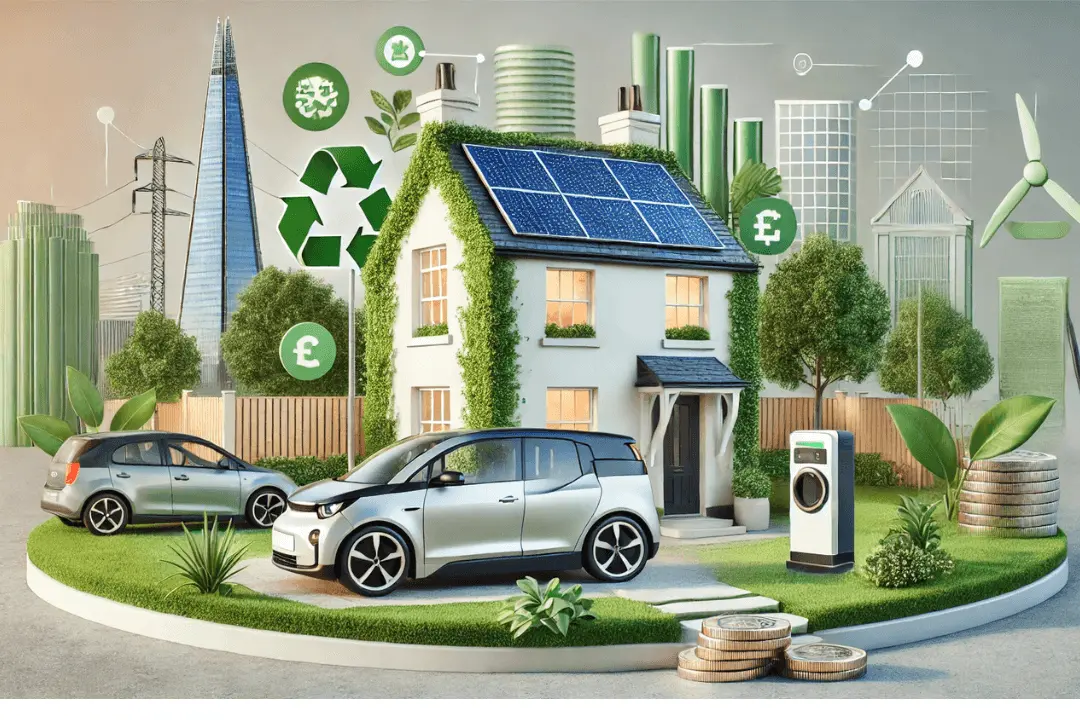Green Loans in the UK: Financing A Sustainable Future
Green Loans: A green loan is designed to help individuals and businesses fund environmentally friendly projects and upgrades, encouraging sustainable living. As environmental awareness rises and the UK government pushes for lower carbon emissions, green loans have gained popularity. In this article, we’ll explore the essentials of green loans in the UK, their benefits, eligibility criteria, available options, and how they contribute to a greener economy.
What Are Green Loans?
Green loans are a type of financing specifically for projects that positively impact the environment. They typically come with competitive interest rates and favorable repayment terms, making it easier for people to undertake eco-friendly projects. Projects funded by green loans might include:
- Home insulation and energy-efficient windows
- Renewable energy installations (e.g., solar panels or wind turbines)
- Heat pumps and other energy-efficient heating systems
- Electric vehicle (EV) charging points
- Rainwater harvesting systems and eco-friendly water management
Also Read: Development Loans in the UK: An Overview
Why Are Green Loans Important?
Green loans play a crucial role in this target by:
- Reducing Carbon Footprint: Funding energy-efficient upgrades for homes and businesses lowers carbon emissions and reliance on non-renewable energy.
- Promoting Renewable Energy: Supporting households and businesses in adopting renewable energy reduces overall energy demand and dependency on fossil fuels.
- Boosting Economic Sustainability: Incentivizing green improvements helps develop the green sector, creating jobs and stimulating economic growth in sustainable industries.

Types of Green Loans Available in the UK
There are a few main types of green loans, each tailored to specific purposes:
- Personal Green Loans: For individuals looking to improve their home’s energy efficiency. These loans are unsecured, meaning there is no need for any asset to be provided to the lender as collateral. However, some personal green loans are secured against property, offering higher loan amounts and lower interest rates.
- Business Green Loans: Aimed at helping businesses upgrade their facilities to become more eco-friendly. These loans are used for large projects such as solar installations, upgrading lighting, or retrofitting buildings with sustainable materials.
- Green Mortgages: Some lenders offer green mortgages with lower rates or cashback incentives if the property meets energy-efficiency standards or the loan is used to fund eco-friendly home improvements.
- Government-Backed Green Financing: Programs such as the Green Deal and Home Upgrade Grant have been introduced to help UK residents make their homes energy-efficient. While some of these schemes may be grants rather than loans, they often work alongside green loans, helping to fund major improvements.
Eligibility Criteria for Green Loans
Green loan eligibility typically depends on a few factors:
- Type of Project: The project should aim to improve energy efficiency or reduce environmental impact.
- Credit Score: Like other loans, lenders assess credit scores to determine the risk level and loan terms.
- Income Level and Financial Stability: Lenders may require proof of income to assess repayment capability.
- Property Type and Ownership: For home green loans, the property should be owned by the borrower. Leaseholders may need the freeholder’s permission.
Benefits of These Loans
- Lower Interest Rates: These loans sometimes have lower rates than traditional loans, as they promote activities aligned with the government’s environmental goals.
- Energy Savings: The energy-efficient improvements funded by these loans can significantly reduce utility bills over time, offering savings.
- Increased Property Value: Homes with energy-efficient features often see increased market value, especially as more buyers prioritize sustainability.
- Environmental Impact: By reducing carbon emissions, these loans help mitigate climate change and promote eco-friendly living.
How to Apply for a Green Loan
To apply for a green loan, follow these steps:
- Research and Compare Options: Look for lenders offering these loans and compare their interest rates, terms, and eligibility requirements. Many high street banks, credit unions, and online lenders in the UK offer green loans.
- Prepare a Detailed Project Plan: Most lenders require a project proposal outlining the eco-friendly upgrades and their estimated costs.
- Submit Application and Documentation: Provide necessary documents, including proof of income, property details, and the project plan.
- Review and Accept Loan Terms: Once approved, review the loan terms carefully to understand repayment schedules and other conditions before signing.
Popular Green Loan Providers In The UK
Several banks and financial institutions in the UK offer the following loans:
- Barclays Green Home Mortgages: Barclays offers favorable mortgage terms for properties with high energy-efficiency ratings.
- NatWest Green Loans: Provides these loans to small and medium-sized enterprises (SMEs) focused on eco-friendly upgrades.
- HSBC Green Loans: Offers these loans for home improvements and renewable energy projects.
- Co-operative Bank: Known for its ethical lending policies, Co-operative Bank also provides green financing options.
Challenges and Considerations
While these loans present numerous advantages, there are challenges to consider:
- Initial Costs: The upfront costs for green projects can be high. While these loans cover these expenses, repayment still requires financial planning.
- Market Availability: These loans are relatively new, so availability may vary depending on the lender, location, and loan terms.
- Approval Process: These loans sometimes have more specific requirements, which can complicate the approval process compared to traditional loans.
Conclusion
These loans offer a valuable opportunity for UK residents to invest in a sustainable future while reaping economic and environmental benefits. With various options available and government support on the rise, these loans are increasingly accessible for both individuals and businesses. By understanding the types of these loans and their potential impact, borrowers can make informed choices that align with both financial goals and environmental responsibility.
